Seat Alhambra 2007 Owner's Guide
Manufacturer: SEAT, Model Year: 2007, Model line: Alhambra, Model: Seat Alhambra 2007Pages: 291, PDF Size: 9.13 MB
Page 21 of 291
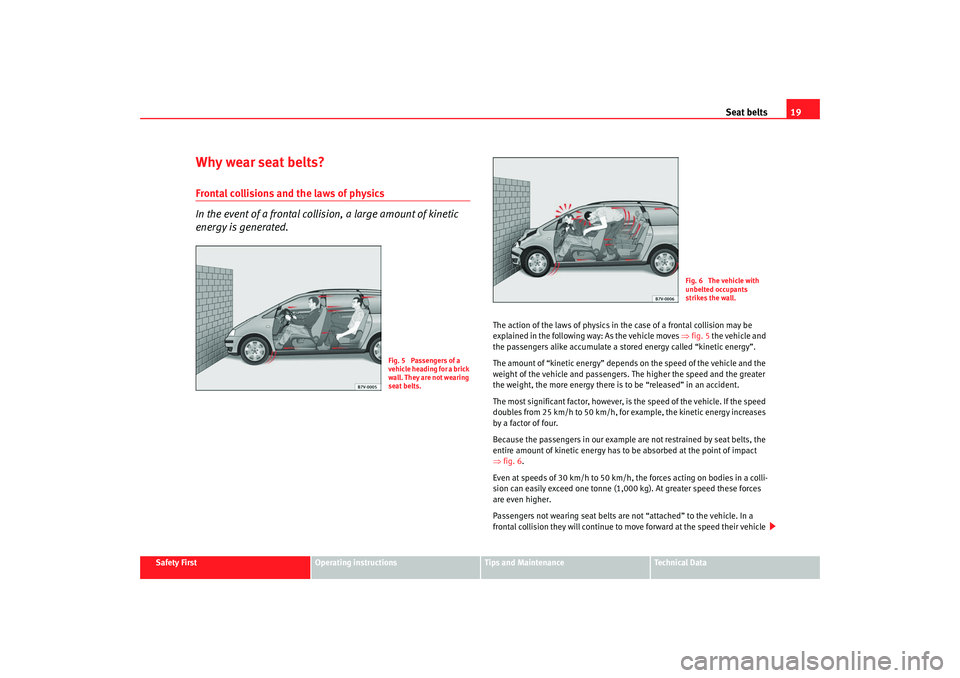
Seat belts19
Safety First
Operating instructions
Tips and Maintenance
Te c h n i c a l D a t a
Why wear seat belts?Frontal collisions and the laws of physics
In the event of a frontal collision, a large amount of kinetic
energy is generated.
The action of the laws of physics in the case of a frontal collision may be
explained in the following way: As the vehicle moves ⇒fig. 5 the vehicle and
the passengers alike accumulate a stored energy called “kinetic energy”.
The amount of “kinetic energy” depends on the speed of the vehicle and the
weight of the vehicle an d passengers. The higher the speed and the greater
the weight, the more energy there is to be “released” in an accident.
The most significant factor, however, is the speed of the vehicle. If the speed
doubles from 25 km/h to 50 km/h, for example, the kinetic energy increases
by a factor of four.
Because the passengers in our example are not restrained by seat belts, the
entire amount of kinetic energy has to be absorbed at the point of impact
⇒ fig. 6 .
Even at speeds of 30 km/h to 50 km/h, the forces acting on bodies in a colli-
sion can easily exceed one tonne (1,000 kg). At greater speed these forces
are even higher.
Passengers not wearing seat belts are not “attached” to the vehicle. In a
frontal collision they will continue to move forward at the speed their vehicle
Fig. 5 Passengers of a
vehicle heading for a brick
wall. They are not wearing
seat belts.
Fig. 6 The vehicle with
unbelted occupants
strikes the wall.
alhambra ingles.book Seite 19 Donnerstag, 19. April 2007 4:04 16
Page 22 of 291
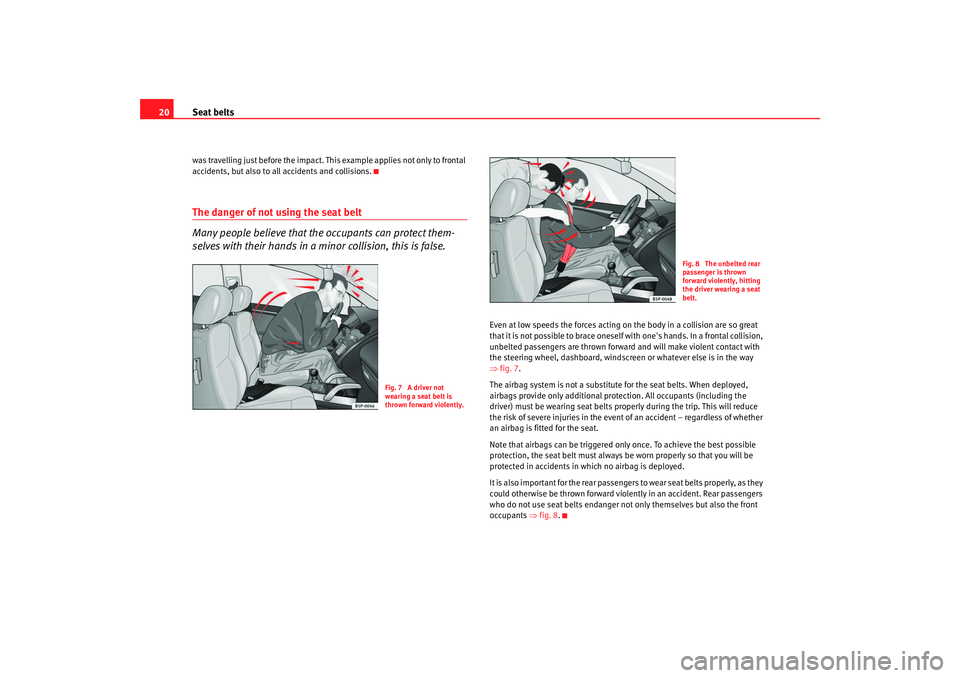
Seat belts
20was travelling just before the impact. This example applies not only to frontal
accidents, but also to all accidents and collisions.The danger of not using the seat belt
Many people believe that the occupants can protect them-
selves with their hands in a minor collision, this is false.
Even at low speeds the forces acting on the body in a collision are so great
that it is not possible to brace oneself with one's hands. In a frontal collision,
unbelted passengers are thrown forward and will make violent contact with
the steering wheel, dashboard, windscreen or whatever else is in the way
⇒ fig. 7 .
The airbag system is not a substitute for the seat belts. When deployed,
airbags provide only additional protection. All occupants (including the
driver) must be wearing seat belts properly during the trip. This will reduce
the risk of severe injuries in the event of an accident – regardless of whether
an airbag is fitted for the seat.
Note that airbags can be triggered only once. To achieve the best possible
protection, the seat belt must always be worn properly so that you will be
protected in accidents in which no airbag is deployed.
It is also important for the rear passengers to wear seat belts properly, as they
could otherwise be thrown forward violently in an accident. Rear passengers
who do not use seat belts endanger no t only themselves but also the front
occupants ⇒fig. 8 .
Fig. 7 A driver not
wearing a seat belt is
thrown forward violently.
Fig. 8 The unbelted rear
passenger is thrown
forward violently, hitting
the driver wearing a seat
belt.
alhambra ingles.book Seite 20 Donnerstag, 19. April 2007 4:04 16
Page 23 of 291
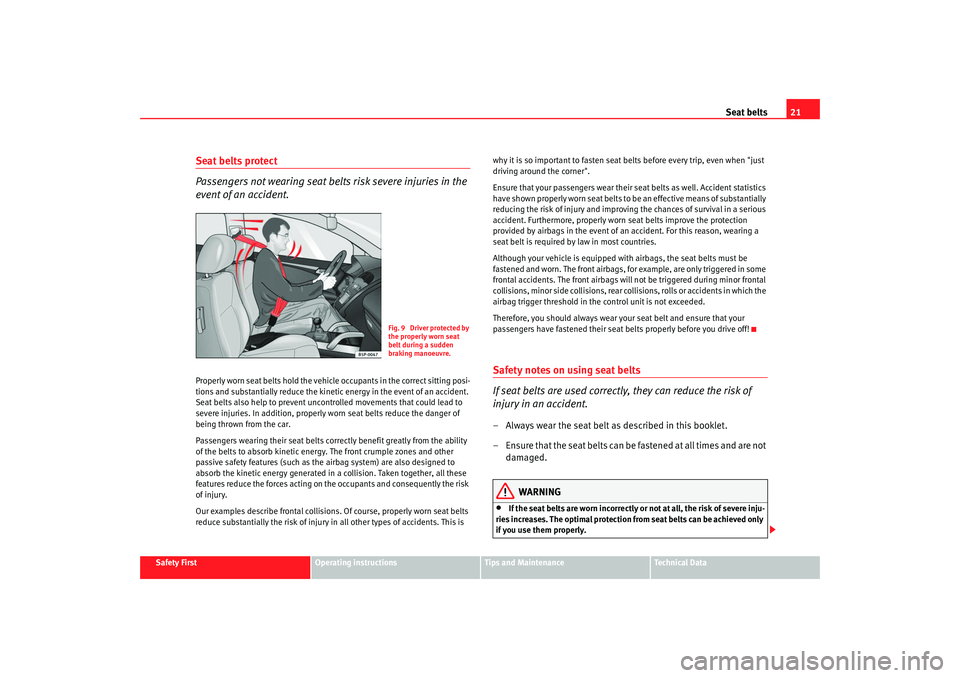
Seat belts21
Safety First
Operating instructions
Tips and Maintenance
Te c h n i c a l D a t a
Seat belts protect
Passengers not wearing seat belts risk severe injuries in the
event of an accident.Properly worn seat belts hold the vehicle occupants in the correct sitting posi-
tions and substantially reduce the kinetic energy in the event of an accident.
Seat belts also help to prevent uncontrolled movements that could lead to
severe injuries. In addition, properly worn seat belts reduce the danger of
being thrown from the car.
Passengers wearing their s eat belts correctly benefit greatly from the ability
of the belts to absorb kinetic energy. The front crumple zones and other
passive safety features (such as the airbag system) are also designed to
absorb the kinetic energy generated in a collision. Taken together, all these
features reduce the forces acting on the occupants and consequently the risk
of injury.
Our examples describe frontal collisions . Of course, properly worn seat belts
reduce substantially the risk of injury in all other types of accidents. This is why it is so important to fasten seat
belts before every trip, even when "just
driving around the corner".
Ensure that your passengers wear their seat belts as well. Accident statistics
have shown properly worn seat belts to be an effective means of substantially
reducing the risk of injury and improvi ng the chances of survival in a serious
accident. Furthermore, properly worn seat belts improve the protection
provided by airbags in the event of an accident. For this reason, wearing a
seat belt is required by law in most countries.
Although your vehicle is equipped with airbags, the seat belts must be
fastened and worn. The front airbags, for example, are only triggered in some
frontal accidents. The front airbags will not be triggered during minor frontal
collisions, minor side collisions, rear collisions, rolls or accidents in which the
airbag trigger threshold in the control unit is not exceeded.
Therefore, you should always wear your seat belt and ensure that your
passengers have fastened their seat belts properly before you drive off!
Safety notes on using seat belts
If seat belts are used correctly, they can reduce the risk of
injury in an accident.– Always wear the seat belt as described in this booklet.
– Ensure that the seat belts can be fastened at all times and are not damaged.
WARNING
•
If the seat belts are worn incorrectly or not at all, the risk of severe inju-
ries increases. The optimal protection from seat belts can be achieved only
if you use them properly.
Fig. 9 Driver protected by
the properly worn seat
belt during a sudden
braking manoeuvre.
alhambra ingles.book Seite 21 Donnerstag, 19. April 2007 4:04 16
Page 24 of 291
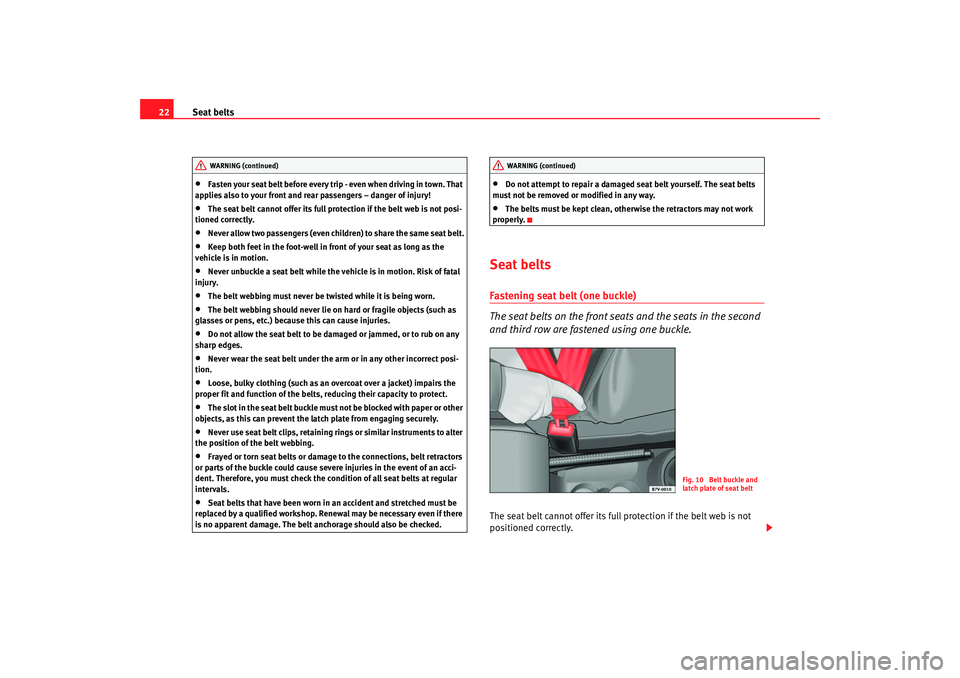
Seat belts
22•
Fasten your seat belt before every trip - even when driving in town. That
applies also to your front and rear passengers – danger of injury!
•
The seat belt cannot offer its full prot ection if the belt web is not posi-
tioned correctly.
•
Never allow two passengers (even children) to share the same seat belt.
•
Keep both feet in the foot-well in front of your seat as long as the
vehicle is in motion.
•
Never unbuckle a seat belt while the vehicle is in motion. Risk of fatal
injury.
•
The belt webbing must never be twisted while it is being worn.
•
The belt webbing should never lie on hard or fragile objects (such as
glasses or pens, etc.) because this can cause injuries.
•
Do not allow the seat belt to be da maged or jammed, or to rub on any
sharp edges.
•
Never wear the seat belt under the arm or in any other incorrect posi-
tion.
•
Loose, bulky clothing (such as an overcoat over a jacket) impairs the
proper fit and function of the belts, reducing their capacity to protect.
•
The slot in the seat belt buckle must not be blocked with paper or other
objects, as this can prevent the latch plate from engaging securely.
•
Never use seat belt clips, retaining rings or similar instruments to alter
the position of the belt webbing.
•
Frayed or torn seat belts or damage to the connections, belt retractors
or parts of the buckle could cause severe injuries in the event of an acci-
dent. Therefore, you must check the co ndition of all seat belts at regular
intervals.
•
Seat belts that have been worn in an accident and stretched must be
replaced by a qualified workshop. Renewal may be necessary even if there
is no apparent damage. The belt anchorage should also be checked.
•
Do not attempt to repair a damaged seat belt yourself. The seat belts
must not be removed or modified in any way.
•
The belts must be kept clean, ot herwise the retractors may not work
properly.
Seat beltsFastening seat belt (one buckle)
The seat belts on the front seats and the seats in the second
and third row are fastened using one buckle.The seat belt cannot offer its full protection if the belt web is not
positioned correctly.
WARNING (continued)
WARNING (continued)
Fig. 10 Belt buckle and
latch plate of seat belt
alhambra ingles.book Seite 22 Donnerstag, 19. April 2007 4:04 16
Page 25 of 291

Seat belts23
Safety First
Operating instructions
Tips and Maintenance
Te c h n i c a l D a t a
– Adjust the seat and head restraint correctly.
– To fasten the belt, take hold of the latch plate and pull it slowly
across your chest and lap ⇒.
– Insert the latch plate into the buckle for the appropriate seat and push it down until it is securely locked with an audible click
⇒page 22, fig. 10.
– Pull the belt to ensure that the latch plate is securely engaged in the buckle.Every seat belt is equipped with an automatic belt retractor on the shoulder
belt. Full freedom of movement is permi tted when the shoulder belt is pulled
slowly. However, during sudden braking, during travel in mountains or bends
and during acceleration, the automati c retractor on the shoulder belt is
locked.
The automatic belt retractors on the front seats are fitted with belt tension
devices.
WARNING
An incorrectly worn seat belt web can cause severe injuries in the event of
an accident.•
The seat belts offer best protection only when the backrests are in an
upright position and the seat belt s have been fastened properly.
•
Never put the latch plate in the buckle of another seat. If you do this, the
seat belt will not protect you properly and the risk of injury is increased.
•
If an occupant is incorrectly belted in, the belt cannot protect him or her
properly. An incorrectly positioned belt web can cause extremely severe
injuries.
Fastening seat belts (with two buckles)
The seat belt for the centre seat in the second row of seats is
fastened using two buckles.– Adjust the seat and head restraint correctly.
– Pull the belt so that the tongue ⇒fig. 11 is pulled down.
– Insert the tongue into the buckle belonging to the seat and push it down until it is secu rely locked with an audible click.
– Use latch plate of the belt to pull the belt across your lap.
– Insert latch plate into the buckle belonging to seat and push it down until it is securely locked with an audible click.
– Pull the belt to ensure that both latch plates are securely
engaged in the buckles.
Fig. 11 Fastening the
seat belt on the centre
seat in the second row of
seatsA1
A1
AA
A2
A2
AB
alhambra ingles.book Seite 23 Donnerstag, 19. April 2007 4:04 16
Page 26 of 291

Seat belts
24The seat belt for the centre seat in the second row of seats has a belt retractor
fitted in the car roof. Full freedom of movement is permitted when the
shoulder belt is pulled slowly. However, during sudden braking, during travel
in mountains or bends and during acceleration, the automatic retractor on
the seat belt is locked.
WARNING
An incorrectly worn seat belt web can cause severe injuries in the event of
an accident.•
The seat belts offer best protection only when the backrests are in an
upright position and the seat belts have been fastened properly.
•
Never put the latch plate in the buckle of another seat. If you do this, the
seat belt will not protect you properly and the risk of injury is increased.
•
If an occupant is incorrectly belted in, the belt cannot protect him or her
properly. An incorrectly positioned belt web can cause extremely severe
injuries.Note
An illustration of how to fasten the seat belts can be found on each buckle.
Seat belt position
Seat belts offer their maximum protection only when they are
properly positioned.
Fig. 12 Correct belt web
and head restraint posi-
tions, viewed from frontFig. 13 Correct belt web
and head restraint posi-
tions, viewed from side
alhambra ingles.book Seite 24 Donnerstag, 19. April 2007 4:04 16
Page 27 of 291
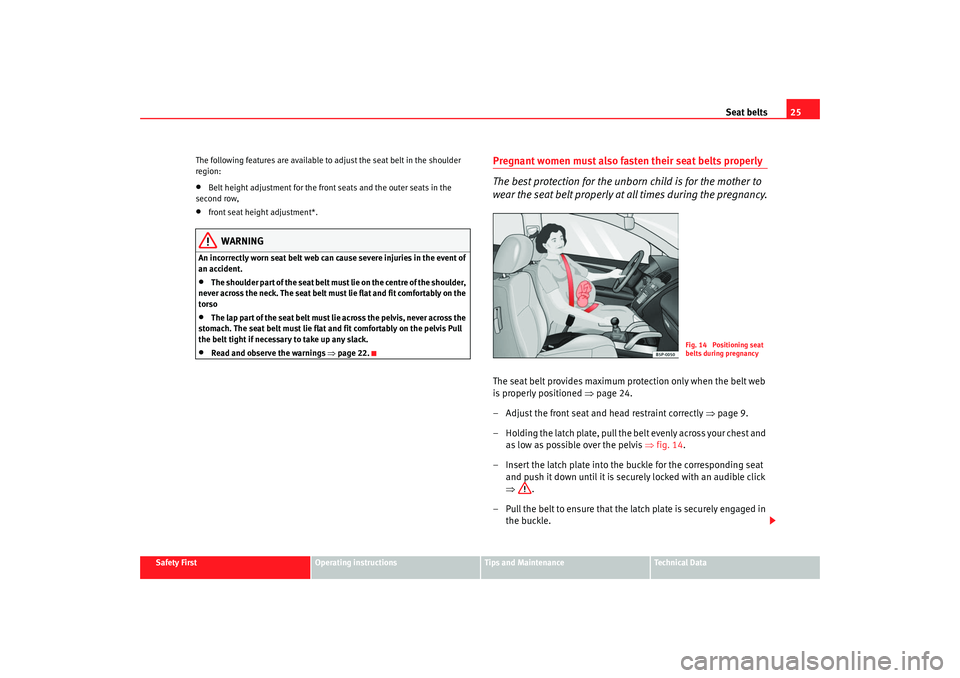
Seat belts25
Safety First
Operating instructions
Tips and Maintenance
Te c h n i c a l D a t a
The following features are available to adjust the seat belt in the shoulder
region:
•
Belt height adjustment for the front seats and the outer seats in the
second row,
•
front seat height adjustment*.
WARNING
An incorrectly worn seat belt web can cause severe injuries in the event of
an accident.•
The shoulder part of the seat belt must lie on the centre of the shoulder,
never across the neck. The seat belt must lie flat and fit comfortably on the
torso
•
The lap part of the seat belt must l ie across the pelvis, never across the
stomach. The seat belt must lie flat and fit comfortably on the pelvis Pull
the belt tight if necessary to take up any slack.
•
Read and observe the warnings ⇒page 22.
Pregnant women must also fasten their seat belts properly
The best protection for the unborn child is for the mother to
wear the seat belt properly at all times during the pregnancy.The seat belt provides maximum protection only when the belt web
is properly positioned ⇒page 24.
– Adjust the front seat and head restraint correctly ⇒page 9.
– Holding the latch plate, pull the belt evenly across your chest and as low as possible over the pelvis ⇒ fig. 14.
– Insert the latch plate into the buckle for the corresponding seat and push it down until it is securely locked with an audible click
⇒ .
– Pull the belt to ensure that the latch plate is securely engaged in the buckle.
Fig. 14 Positioning seat
belts during pregnancy
alhambra ingles.book Seite 25 Donnerstag, 19. April 2007 4:04 16
Page 28 of 291
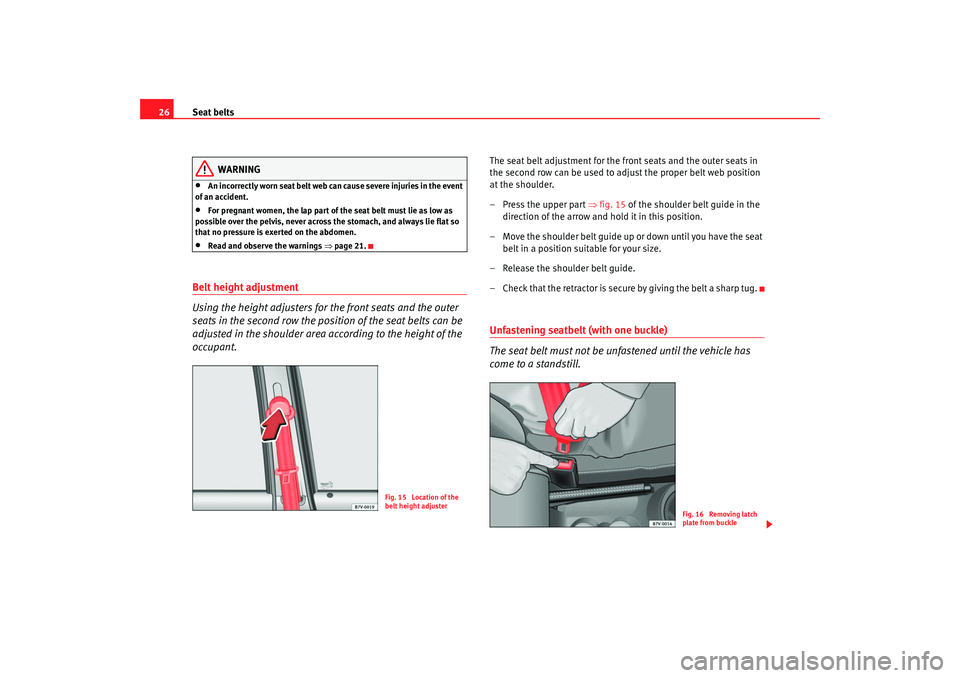
Seat belts
26
WARNING
•
An incorrectly worn seat belt web c an cause severe injuries in the event
of an accident.
•
For pregnant women, the lap part of the seat belt must lie as low as
possible over the pelvis, never across the stomach, and always lie flat so
that no pressure is exerted on the abdomen.
•
Read and observe the warnings ⇒ page 21.
Belt height adjustment
Using the height adjusters for the front seats and the outer
seats in the second row the position of the seat belts can be
adjusted in the shoulder area according to the height of the
occupant.
The seat belt adjustment for the front seats and the outer seats in
the second row can be used to adjust the proper belt web position
at the shoulder.
–Press the upper part ⇒fig. 15 of the shoulder belt guide in the
direction of the arrow and hold it in this position.
– Move the shoulder belt guide up or down until you have the seat belt in a position suitable for your size.
– Release the shoulder belt guide.
– Check that the retractor is secure by giving the belt a sharp tug.Unfastening seatbelt (with one buckle)
The seat belt must not be unfastened until the vehicle has
come to a standstill.
Fig. 15 Location of the
belt height adjuster
Fig. 16 Removing latch
plate from buckle
alhambra ingles.book Seite 26 Donnerstag, 19. April 2007 4:04 16
Page 29 of 291
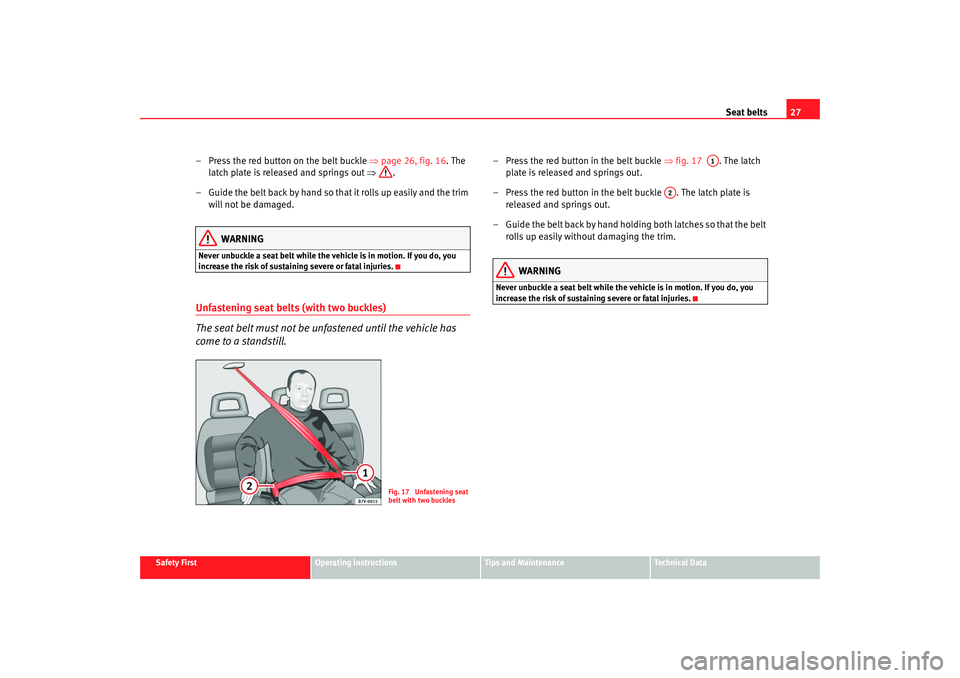
Seat belts27
Safety First
Operating instructions
Tips and Maintenance
Te c h n i c a l D a t a
– Press the red button on the belt buckle ⇒ page 26, fig. 16. The
latch plate is released and springs out ⇒.
– Guide the belt back by hand so that it rolls up easily and the trim will not be damaged.
WARNING
Never unbuckle a seat belt while the vehicle is in motion. If you do, you
increase the risk of sustaining severe or fatal injuries.Unfastening seat belts (with two buckles)
The seat belt must not be unfastened until the vehicle has
come to a standstill.
– Press the red button in the belt buckle ⇒fig. 17 . The latch
plate is released and springs out.
– Press the red button in the belt buckle . The latch plate is released and springs out.
– Guide the belt back by hand holding both latches so that the belt rolls up easily without damaging the trim.
WARNING
Never unbuckle a seat belt while the vehicle is in motion. If you do, you
increase the risk of sustaining severe or fatal injuries.
Fig. 17 Unfastening seat
belt with two buckles
A1
A2
alhambra ingles.book Seite 27 Donnerstag, 19. April 2007 4:04 16
Page 30 of 291
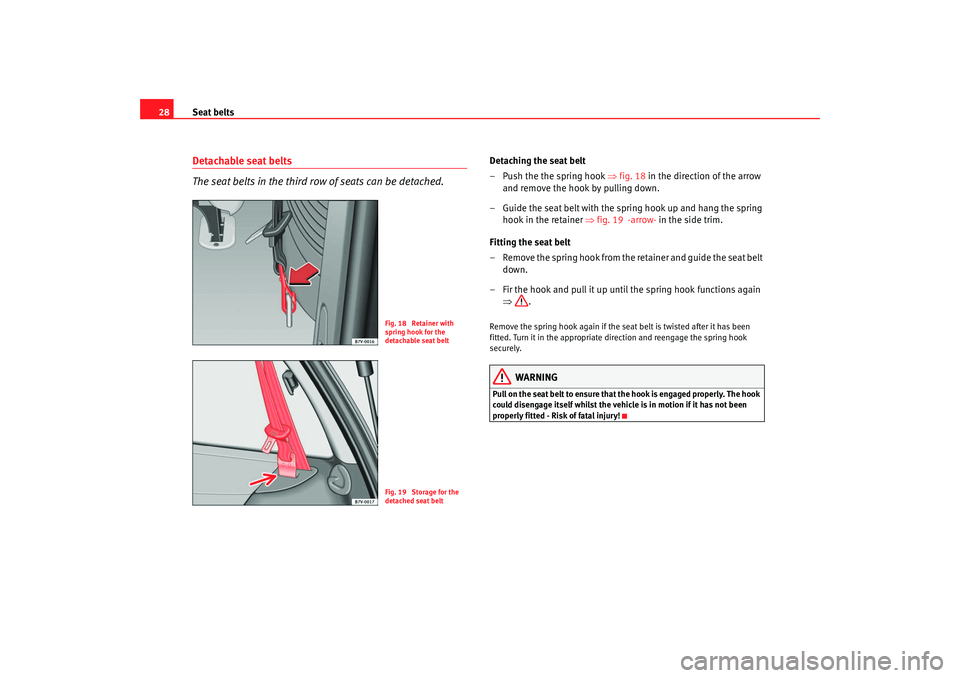
Seat belts
28Detachable seat belts
The seat belts in the third row of seats can be detached.
Detaching the seat belt
– Push the the spring hook ⇒fig. 18 in the direction of the arrow
and remove the hook by pulling down.
– Guide the seat belt with the spring hook up and hang the spring hook in the retainer ⇒fig. 19 -arrow- in the side trim.
Fitting the seat belt
– Remove the spring hook from the retainer and guide the seat belt down.
– Fir the hook and pull it up until the spring hook functions again ⇒ .Remove the spring hook again if the seat belt is twisted after it has been
fitted. Turn it in the ap propriate direction and re engage the spring hook
securely.
WARNING
Pull on the seat belt to ensure that the hook is engaged properly. The hook
could disengage itself whilst the vehicl e is in motion if it has not been
properly fitted - Risk of fatal injury!
Fig. 18 Retainer with
spring hook for the
detachable seat beltFig. 19 Storage for the
detached seat belt
alhambra ingles.book Seite 28 Donnerstag, 19. April 2007 4:04 16